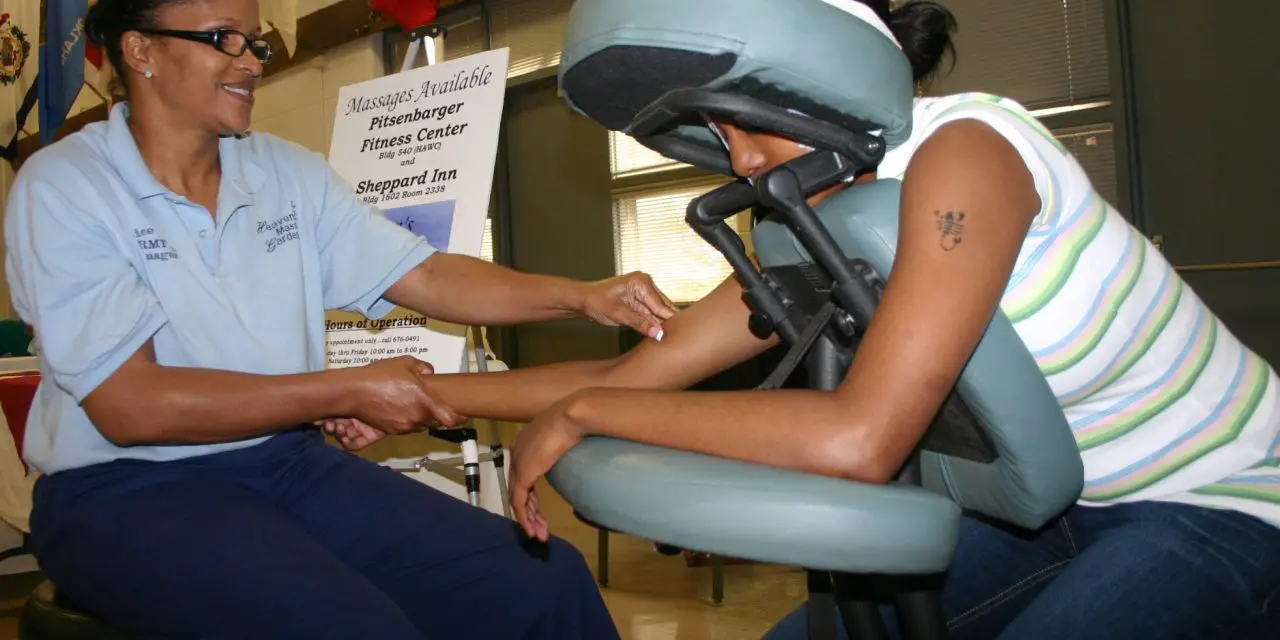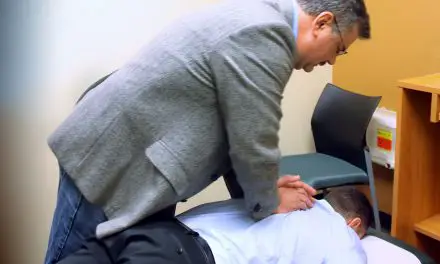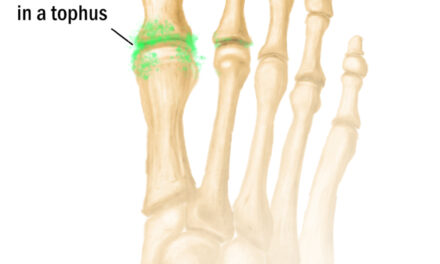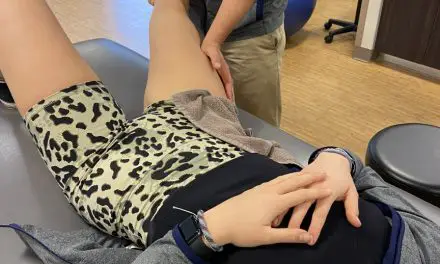Humans have found all sorts of ways to adapt massage to the culture, the environment, and the resources available, and that means there are more options for varieties of massage than even a seasoned massage therapist can name. Whether you’re an office worker, a convention attendee, a grocery shopper, or a weary airline traveler, you might find your answer waiting for you in a plush chair with the round face pillow.
Resting with your upper body with a slight forward lean and your face gently resting in the pillow, a therapist can knead your back, neck, and shoulders without requiring you to undress. Chair massage has loads of benefits that separate the experience from other styles, which makes it the most approachable intro to massage therapy for most people.
Benefits of chair massage
Some reasons to try a chair massage are obvious. For most people, it just feels good! That may sound simple but that benefit is powerful and should not be overlooked.
Chair massage is also usually the cheapest option available for a professional massage. In case you need some more convincing, you may be interested to know that helpful scientists have actually studied and identified some potential real-world benefits that massage therapy can offer you.
One of the most studied potentials for benefit in the world of massage research is analgesic effect, a term for what is commonly referred to as pain relief. Although no single gold-standard study has “proof” that massage will reduce your pain exists, this 2019 review shows that not only is massage typically very safe, but there are also a lot of low to moderate quality studies that suggest massage therapy may be worth a try when it comes to pain relief.
How exactly is massage creating an analgesic effect? Frankly, that question doesn’t have a clear-cut answer. Several popular explanations have been explored by researchers including possible modulating effects on the musculoskeletal, nervous, and immune systems. However, many factors—including some difficulties inherent to studying massage therapy—have made it all but impossible to pin down one discrete mechanism of action over another with a high degree of confidence.
“Why exactly does massage help people who experience persistent pain?” is a question that tends to come back answered “probably for lots of reasons” because no one shining mechanism of action has been, or maybe ever will be, identified. Instead we keep on finding more and more new potential explanations, like this 2017 randomized-controlled trial that uses massage therapy for folks with chronic back pain.
The investigators had participants in the trial randomly assigned to either keep their eyes closed, view a picture of their own back, watch a video of another person being massaged, or to watch real-time video of their own back—all while being treated with conventional massage therapy.
They found that all of the options resulted in decreased habitual pain compared with looking at a neutral object and among all the options, viewing real-time video of their own back being massaged had the strongest analgesic effect.
If just watching your back get a massage or even just looking at a picture of someone else’s can induce analgesic effects, does the average person really need to pin down one exact reason why massage for pain relief is potentially worthwhile? Probably not.
While we may not understand perfectly why massage seems to lead so many people to report pain relief, or improved quality of life, or stress reductionpain that many people choose to pursue massage for these reasons and many of those folks walk away satisfied with their choice.
Massage chairs allow therapists to travel and set up a treatment area much more easily than a traditional massage table. People who receive chair massage tend to feel comfortable enough with the clothed and seated style to receive their massage in open view of other people rather than requiring a private room.
Chair massages also tend to be shorter in duration than table massages, roughly 10 to 15 minutes rather than 30 to 60 minutes. That may not seem like a benefit, especially when your time in the chair is coming to an end, but shorter durations also increase accessibility for groups which makes this style a great choice for teams, events, and special occasions.
These unique benefits combined mean you can find chair massage in all sorts of places that other styles of massage simply cannot go. This is a huge benefit for therapists too, who often use chair massage as a way of presenting their service to many more people than would otherwise see or experience massage if it were not for chair massage.
What are chair massage techniques?
Just like any other types of massage, chair massage techniques will vary among therapists. The use of deep pressure or trigger point therapy tends to be less common in chair massage because it’s tougher for the therapist to leverage their body weight to press downward like they would during a table massage. But it’s still possible for some therapists, so you should still discuss your pressure preferences with the therapist getting a massage.
Assuming that you have your pressure preferences dialed in with your therapist, there are a few common techniques you can expect.
Petrissage
A petrissage of the trapezius muscles (the ones that fill the space between the sides of your neck and tops of your shoulders) is perhaps the most common. If your massage therapist leaves out this wonderful kneading technique for both sides of the neck and shoulders, try another therapist before you write off chair massage! It’s a real crowd-pleaser.
Compression
This technique sounds exactly like what it is. A compression used in a chair massage tends to be used as a beginning, transitional, or ending stroke by the therapist and feels most often like a comforting broad squeezing pressure. When the therapist massages you with clothes on, they could not use any oil to lubricate and slide over your body. Thus, compression becomes the therapist’s best friend for delivering comfortable and seemingly continuous flow to a treatment.
Tapotement
Also known as percussion, this technique can be delivered fast or slow, with open or closed hands. It tends invigorates rather than to relax. While it can be used at any time during a chair massage, you see this technique used most often to end a treatment. A relaxing drumming or chopping up and down the back can help the therapist to avoid rousing you if you have nodded off.
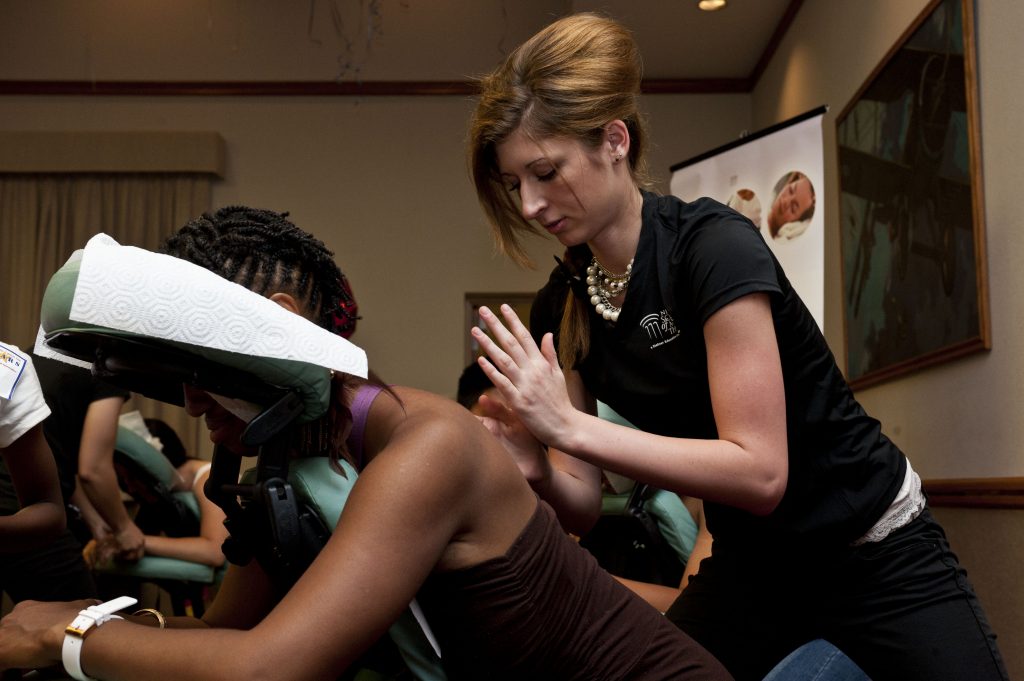
Shaylene Williams, Nevada School of Massage Therapy first quarter student, gives Crystal Cummings, a military spouse, a back massage during a Military Spouse Appreciation Day event May 11, 2012, at Nellis Air Force Base, Nev. Military spouses were offered free massages to help them to relax and unwind, and as a way of showing the base’s appreciation for their support. (U.S. Air Force photo by Airman 1st Class Jason Couillard)
What can you expect from a chair massage?
If you want to try a chair massage, here are a few things you should expect.
1. Expect to sit in a chair. This is probably going to be a purpose-made massage chair which for some people may not be immediately intuitive to sit in, but your therapist should offer you guidance and/or a demonstration if you are new to a massage chair. Chair massage can also be enjoyed in a standard chair with a bit of guidance from the therapist and maybe some towels or pillows to help bolster you into a comfortable position.
2. Expect to remain fully clothed. It’s possible folks in colder climates and/or wearing layers may be asked if they are comfortable removing a sweater or jacket. The same goes for certain kinds of jewelry like large necklaces or earrings, which may pose an obstacle to the therapist. Conversely, some clothing like tank tops may improve access and allow for some direct skin-to-skin contact around the neck or shoulders.
You should always communicate with the therapist about what is comfortable for you in terms of any sort of disrobing. There is no reason a professional chair massage to require anyone to disrobe completely or to any degree beyond their personal comfort.
3. Expect the therapist will NOT use oil/lotion. Most chair massages don’t use lubricant at all and that tends to line up well with the set and setting where chair massage is being provided. No one wants oily hair before the big meeting! However, it is not out of the question that a therapist may use some sort of lubricant though, so as always, make sure you communicate your preferences before you begin.
4. Expect it to last around 10-15 minutes. This is very broadly standard timing for chair massage in most settings, but many therapists offer extra time if you ask for it and if circumstances allow it.
5. Expect it to be less private than table massage. Chair massage is often done in setting where other people may be around and can see it taking place. This is not a requirement, but it’s likely since chair massage tends to be chosen in part for its more public accessibility and good fit for groups and events.
6. Expect to stand up from the chair. You may feel reluctant to stand up after a chair massage, but that’s a great sign that you had received an awesome massage!
Therapists are dependent on your feedback to deliver chair massage safely, to improve their skills, and to avoid negative outcomes. They may even be able to help give you some guidance on improving any negative outcome you might experience. If somehow you do end up feeling stressed, uncomfortable, or injured make sure you let the therapist know.
What body parts are often worked on in a chair massage?
Depending on the therapist, the chair, and the person being massaged, there are a number of different possibilities for what parts of the body may be included in a chair massage treatment. If you do not want a particular part of your body to be worked on, tell your therapist that before you begin. It is possible to massage just about any body part, but the seated position typical to chair massage makes some parts easier to access. The most common body parts include neck, shoulders, upper to the low back, upper arms, forearms, hands, scalp, forehead, ears, and face.
This is not meant to be an exhaustive list, and other parts like your lower legs or feet could even be included, but that is not what the average chair massage experience is likely to look like.
How much is a 15 minute chair massage session?
If you’re paying for chair massage, the $1 per minute rate is common. Other cost considerations may include tipping (15-20% is common in many places), possible fees for travel if you’re having your chair massage in-home, and potentially discounted rates for groups if you are going to be paying for multiple massages. If you have about $20, you can probably afford a chair massage right now.
Pricing for chair massage can be variable, depending on the setting. You may not be personally paying anything at all. That’s because chair massage may be provided promotionally free of charge or it could be paid for by your employer or by another third party as a “free-to-you” perk of your employment or the event you’re attending.
Not sure if you should tip if you’re getting the chair massage for free? In many parts of the world, tipping may be common practice for massage therapy. If you’re not sure, don’t hesitate to speak with whomever contracted the therapist. For promotional free services offered by the therapist, you can simply ask them about their tipping policy directly.
Chair massage considerations
Not every variety of massage is a good fit for every person. Chair massage is very accessible in many ways, but the positioning inherent to a chair massage may not be the right fit for some. If you have joint pain or issues with mobility, you may find that getting on to and off of a massage chair is cumbersome or even uncomfortable.
Similarly, folks with certain mental, emotional, and social differences may find chair massage to be personally discomforting in some way. People who are pregnant may decide that the position required by a massage chair isn’t something they are willing to accept. All of those concerns and many more are valid if you are someone who is feeling them. Period. It’s also worth acknowledging that those things might be true at the same time as chair massage also being technically safe to receive.
If you think chair massage may pose some obstacle or another for you, but you’d still like to give it a try, you should absolutely discuss your concerns with the therapist. Many skilled therapists are chock full of tips and tricks for adapting their treatment to consider common obstacles.
Solving that knee pain you might get due to arthritis during a chair massage may be as simple as not resting your shins on the pads of the massage chair. Instead, let your legs extend in front of you as you sit. There are more ways to adapt a treatment than you could ever imagine, so ask tell your therapist about what other options there are.
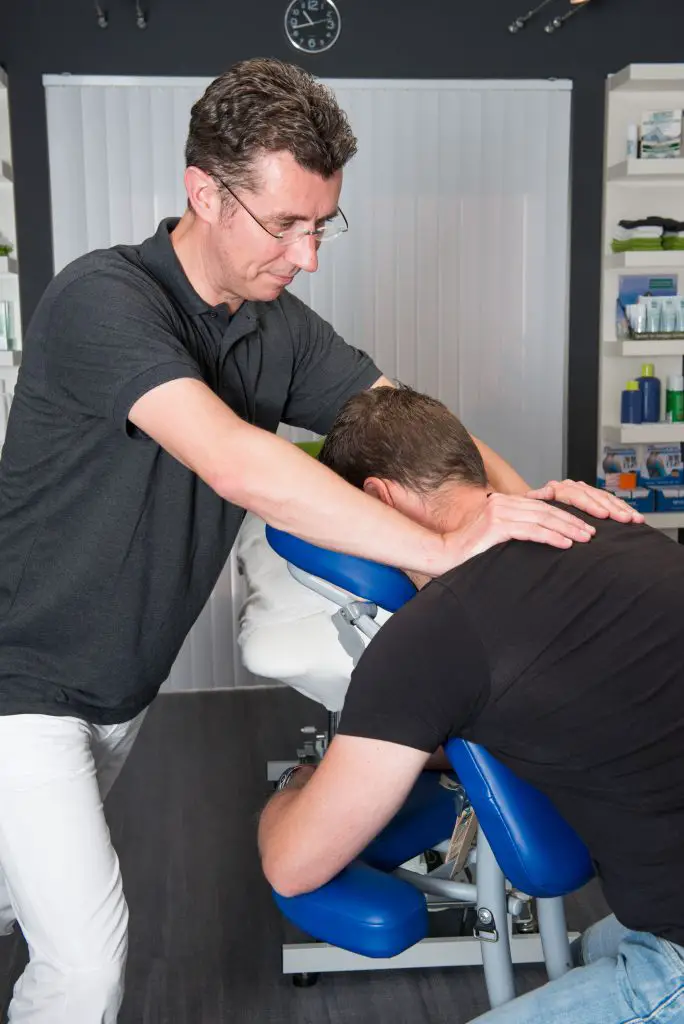
Photo: M.J. Mooij
How to find the best chair massage near you
Chair massage is so accessible that it may be one of the easiest types of massage to find in your area. A trip to the mall or even to the company break room may be all you need to stumble upon a chair massage. Since the best chair massage is a subjective experience, there is no one-size-fits-all approach to finding “the best” one. However, there are a few ideas that most massage therapists would agree.
If you have the chance to see a massage therapist perform a chair massage on someone,, you can usually judge if they are going to do good work if you look for a few things.
1. Do they communicate with the person they are massaging? It’s a red flag if the answer is no. You want to look for someone who is delivering professional and compassionate communication at all stages of their work.
2. Is the person in the chair calmly drifting away to slumberland or are they biting a hole in their lip and tearing up? Everyone’s pressure preferences are different, but you probably want to steer clear of any massage therapist who appears to be crushing or injuring folks in their chair. Find a therapist who pays careful attention to the reaction of the person they are massaging to ensure they are comfortable.
3. Does that therapist properly sanitize their hands and the massage chair between each person? That should be a no-brainer, but it’s also something to look out for.
If you need to find a good chair massage and you don’t have the good luck of stumbling upon a chair massage in progress, there are plenty of other ways to find a therapist who can deliver a solid professional experience. If you live in a part of the world that requires special qualifications to practice massage therapy, like a license or certification, start by searching your local accrediting agencies listings.
In the U.S., for example, many states with licensing requirements also provide online portals to the public to search their records for properly accredited and licensed therapists. If you happen to live near an institution that provides professional massage therapy training, reach out to the local school directly and you may yield more affordable options by way of student clinics (of course, students may not be “the best” while they are still learning).
Popular online review sites like Google or Yelp! can help to provide more insight, but they’re probably not your best bet if you’re going to use them alone without any other resource.
Chair massage is the appetizer or sampler on the massage menu. It has a wonderful appeal in terms of accessibility and affordability, and it provides a critically important way for many massage therapists to gain exposure to new clients.

